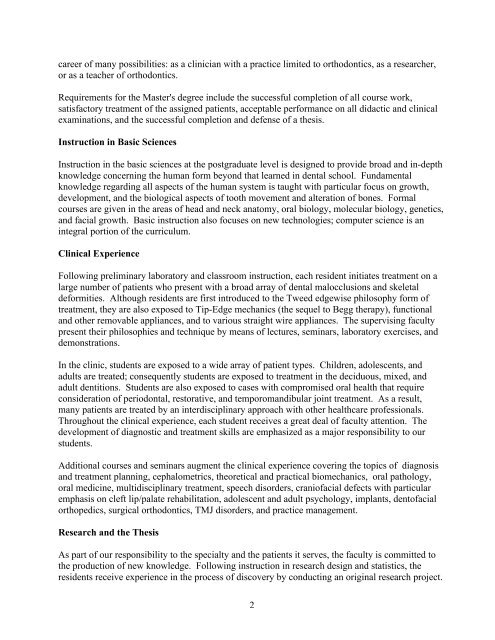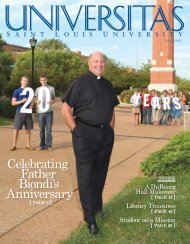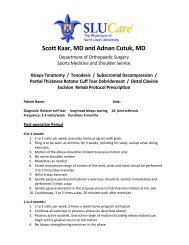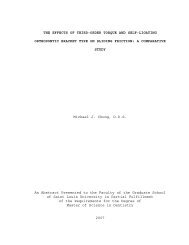Program Manual - Saint Louis University
Program Manual - Saint Louis University
Program Manual - Saint Louis University
Create successful ePaper yourself
Turn your PDF publications into a flip-book with our unique Google optimized e-Paper software.
career of many possibilities: as a clinician with a practice limited to orthodontics, as a researcher,<br />
or as a teacher of orthodontics.<br />
Requirements for the Master's degree include the successful completion of all course work,<br />
satisfactory treatment of the assigned patients, acceptable performance on all didactic and clinical<br />
examinations, and the successful completion and defense of a thesis.<br />
Instruction in Basic Sciences<br />
Instruction in the basic sciences at the postgraduate level is designed to provide broad and in-depth<br />
knowledge concerning the human form beyond that learned in dental school. Fundamental<br />
knowledge regarding all aspects of the human system is taught with particular focus on growth,<br />
development, and the biological aspects of tooth movement and alteration of bones. Formal<br />
courses are given in the areas of head and neck anatomy, oral biology, molecular biology, genetics,<br />
and facial growth. Basic instruction also focuses on new technologies; computer science is an<br />
integral portion of the curriculum.<br />
Clinical Experience<br />
Following preliminary laboratory and classroom instruction, each resident initiates treatment on a<br />
large number of patients who present with a broad array of dental malocclusions and skeletal<br />
deformities. Although residents are first introduced to the Tweed edgewise philosophy form of<br />
treatment, they are also exposed to Tip-Edge mechanics (the sequel to Begg therapy), functional<br />
and other removable appliances, and to various straight wire appliances. The supervising faculty<br />
present their philosophies and technique by means of lectures, seminars, laboratory exercises, and<br />
demonstrations.<br />
In the clinic, students are exposed to a wide array of patient types. Children, adolescents, and<br />
adults are treated; consequently students are exposed to treatment in the deciduous, mixed, and<br />
adult dentitions. Students are also exposed to cases with compromised oral health that require<br />
consideration of periodontal, restorative, and temporomandibular joint treatment. As a result,<br />
many patients are treated by an interdisciplinary approach with other healthcare professionals.<br />
Throughout the clinical experience, each student receives a great deal of faculty attention. The<br />
development of diagnostic and treatment skills are emphasized as a major responsibility to our<br />
students.<br />
Additional courses and seminars augment the clinical experience covering the topics of diagnosis<br />
and treatment planning, cephalometrics, theoretical and practical biomechanics, oral pathology,<br />
oral medicine, multidisciplinary treatment, speech disorders, craniofacial defects with particular<br />
emphasis on cleft lip/palate rehabilitation, adolescent and adult psychology, implants, dentofacial<br />
orthopedics, surgical orthodontics, TMJ disorders, and practice management.<br />
Research and the Thesis<br />
As part of our responsibility to the specialty and the patients it serves, the faculty is committed to<br />
the production of new knowledge. Following instruction in research design and statistics, the<br />
residents receive experience in the process of discovery by conducting an original research project.<br />
2

















